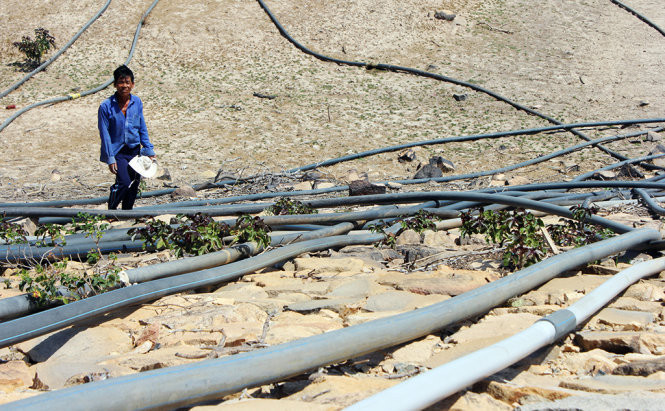Why does Ninh Thuan province have the least rain?
Also located in the tropical monsoon area, Ninh Thuan is a dry province with the least rainfall in the country with only about 700-800mm a year. Why is that?
According to data from the Department of Natural Resources and Environment of Ninh Thuan Province, in the rainy season in 2015, the rainfall in the coastal area in this province is about 600-700mm, the mountain area is about 500-600mm. Meanwhile, the annual rainfall of Vietnam is about 1,500-2,000mm.
The main reason is due to the severity of Ninh Thuan's terrain. The four sides surrounded by mountains stretching out to the sea made this land seem to be inside a closed arch.
Therefore, the monsoon types cannot help bring the moisture from the ocean into the land causing rain.
Moreover, the coast of Ninh Thuan runs in the direction of southwest wind, so it is less likely to receive the influence of the wind that causes rain this summer, while the northeast monsoon is not strong enough when it reaches the South Central.

Ninh Thuan is considered the savanna area in Vietnam with the least rainfall in the country - (Photo: MINH TRAN).
On the contrary, Ninh Thuan is affected by the slippery effect , similar to the windy phenomenon in the North Central provinces. Southwest wind carries moisture causing rain in the Mekong Delta, the Southeast and the Central Highlands, when crossing the mountain to Ninh Thuan, it turns to dry hot.
In particular, the phenomenon of rising water from Ninh Thuan sea to northern Binh Thuan creates a difference for the climate here. The phenomenon of rising water occurs in places where the coastline is parallel to the wind direction, the continental shelf has the appropriate slope, exists of the coastal cold current system in the direction of North - South and is influenced by stability. the degree and direction of the southwest monsoon.
At that time, the wind will cause the sea floor of high temperature and low salinity in the coastal area to be pushed away. At the same time, the water has low temperature and high salinity from the depths will follow the rising slope to the coastal areas to compensate for the lost water.
June to August is a period of strong southwest monsoon activity, so the phenomenon of rising water here is also the most powerful. The atmosphere in this region cannot collect water vapor to make rain because the water is always salty and cold making it difficult to evaporate water.
The climate is less rainy and prolonged drought makes agricultural cultivation difficult, however Ninh Thuan has other advantages. The phenomenon of rising water makes rich nutrients and phytoplankton, creating abundant food sources for marine animals, contributing to turning Ninh Thuan - Binh Thuan sea area into one of the 4 key fishing grounds of the whole country.
At the same time, high salinity of sea water helps the province to be one of the largest and best quality salt production areas in the country with the brand name Ca Na salted in four directions.
- International discussion on nuclear power safety in Ninh Thuan
- Erupting land in Ninh Thuan
- Rain sprinkler technology uses solar energy
- Central Vietnam overcomes flood, the North receives a new cold wave
- Catch the seal in the sea in Ninh Thuan
- There are the safest scenarios for nuclear power plants
- Eruption sludge in Ninh Thuan is a geological disaster
- Mud 'strange' in Ninh Thuan: Unable to survey due to lack of funding
- Lam Dong cracked land, Ninh Thuan mud spray
- Gaur appears in Ninh Thuan forest
- Storm No. 1 is 350km from the coast of Ninh Thuan-Binh Thuan
- Storm No. 12 targets Khanh Hoa - Ninh Thuan, winds of 130km / h
 Is the magnetic North Pole shift dangerous to humanity?
Is the magnetic North Pole shift dangerous to humanity? Washington legalizes the recycling of human bodies into fertilizer
Washington legalizes the recycling of human bodies into fertilizer Lightning stone - the mysterious guest
Lightning stone - the mysterious guest Stunned by the mysterious sunset, strange appearance
Stunned by the mysterious sunset, strange appearance Severe drought in the Central region caused flocks of Ninh Thuan sheep to die and the lake to have a bare bottom and crack
Severe drought in the Central region caused flocks of Ninh Thuan sheep to die and the lake to have a bare bottom and crack  Catch the seal in the sea in Ninh Thuan
Catch the seal in the sea in Ninh Thuan  Discovered two ancient walls in the underground in Binh Thuan
Discovered two ancient walls in the underground in Binh Thuan  Binh Thuan discovered relics of ancient Cham people
Binh Thuan discovered relics of ancient Cham people  Discovered a prehistoric stone herd in Binh Thuan
Discovered a prehistoric stone herd in Binh Thuan  Vietnam successfully produces food from seaweed
Vietnam successfully produces food from seaweed 